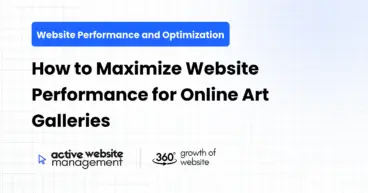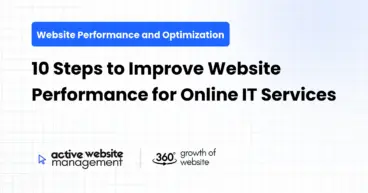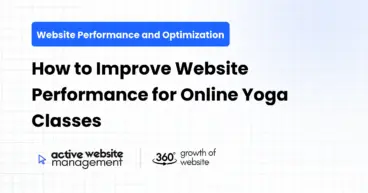December 18, 2024
9 min read
In the digital age, website performance is paramount. Whether you’re running an e-commerce store, a corporate website, or a personal blog, the speed at which your site loads can make or break the user experience. Slow-loading websites lead to higher bounce rates, lower conversion rates, and ultimately, lost revenue. One of the most effective techniques to enhance website performance is caching.
Caching helps reduce the load on your server and ensures that users experience faster loading times when they visit your website. In this comprehensive guide, we will dive deep into the role of caching in website performance, explore different types of caching, and offer practical insights to optimize your site’s performance. Additionally, we will examine how Active Website Management can integrate caching strategies to ensure that your website remains fast and responsive.
1. What is Caching?
Caching is a process used to temporarily store (or “cache”) data that can be quickly accessed when needed, thereby reducing the time and resources required to fetch the data again. In the context of websites, caching refers to storing web page content, scripts, images, and other data in a temporary storage location for faster retrieval.
When a user visits a website, the browser or server caches certain elements of the site. The next time the user visits the site, these elements are loaded from the cache, instead of requesting them from the server, which results in faster page load times.
Reducing Server Load
One of the primary benefits of caching is reducing the load on your server. Each time a user accesses a webpage, the server must process the request, retrieve the necessary files from the database, and then generate the page. This process can be resource-intensive, particularly for high-traffic websites.
By storing the static content of a website in cache, you offload much of the work from the server. Cached content can be served directly to the user without needing to go through the time-consuming process of regenerating the page. This results in faster response times and a reduced load on the server.
Don’t Just Maintain Your Website—
Grow It using Active Website Management! Don't Wait for Growth—Accelerate It with Active Website Management
Improving User Experience
When users encounter slow-loading websites, they are more likely to leave before the page finishes loading. According to a study by Google, 53% of mobile users abandon a page that takes longer than 3 seconds to load. By leveraging caching, you ensure that the content is served quickly, providing a better experience and reducing bounce rates.
Caching ensures that frequently accessed data, like images, stylesheets, and scripts, are loaded instantly. This leads to smoother navigation and faster interactions, enhancing overall user satisfaction.
Website speed is a known ranking factor for search engines, particularly for Google. Faster websites are more likely to rank higher in search results because they provide a better user experience. As caching significantly improves load times, it directly contributes to better SEO performance.
In addition, caching can help reduce the number of HTTP requests, which can result in a cleaner, more streamlined website, further boosting its SEO potential.
3. Types of Caching
There are several types of caching that can be used to optimize website performance. Each caching method serves a unique purpose and can be applied in different scenarios. Let’s explore the most commonly used types of caching:
Browser Caching
Browser caching stores files such as images, CSS files, JavaScript, and HTML documents on the user’s device. When a user visits a website for the first time, the browser downloads and stores these files locally. On subsequent visits, the browser retrieves these files from the local cache instead of downloading them again, which leads to faster load times.
To optimize browser caching, set an appropriate expiry time for cached files so that users’ browsers can store content for longer periods before checking for updates. For example, you can configure your site to cache images for several days or weeks.
Page Caching
Page caching involves storing a fully rendered page in the cache so that it can be served to users without the need for dynamic rendering on each visit. This is particularly useful for static websites or pages that don’t change frequently. When a user visits a cached page, the server simply serves the cached version, bypassing the time-consuming process of generating the page.
Page caching is often used with dynamic websites, where the content might be generated from a database or an API, to speed up the loading time of static content.
Object Caching
Object caching stores pieces of dynamic content, such as database query results, API responses, or complex calculations, in memory. This is ideal for content that is generated from a database but does not change frequently. For instance, if a user visits a page that requires data from a database, object caching allows the server to retrieve this data from memory instead of querying the database again, improving performance.
Database Caching
Database caching stores the results of database queries in memory, allowing repeated queries to be answered more quickly. This can significantly reduce the time it takes to load dynamic pages that rely on frequent database queries, especially in high-traffic websites where database calls can become a bottleneck.
CDN Caching
A Content Delivery Network (CDN) is a network of servers strategically placed around the world. When you use a CDN, static resources like images, JavaScript, and CSS files are cached on these servers. When a user visits your website, the CDN serves the cached files from the server closest to their location, which results in faster load times.
Using a CDN is particularly beneficial for websites with a global audience. It reduces latency and ensures that users experience the same fast load times regardless of their geographic location.
4. How Caching Works: A Simple Breakdown
To better understand how caching works, let’s break down the process:
- Initial Request: The user requests a webpage for the first time. The browser or server retrieves the necessary data and renders the page. The requested data is then stored in the cache for future use.
- Cache Lookup: On subsequent visits, the browser or server checks if the required data is already in the cache. If the data is found in the cache, it is served immediately, leading to a faster load time.
- Cache Expiry: Cached data is not stored indefinitely. Caching mechanisms typically have an expiry time or a “time-to-live” (TTL). Once the cache expires, the browser or server will retrieve fresh content.
- Cache Rebuild: If the cached data is expired or not found, the server will regenerate the content, store it in the cache, and serve it to the user.
Don't Wait for Growth—Accelerate It with
Active Website Management Don't Wait for Growth—Accelerate It with Active Website Management
5. Best Practices for Implementing Caching
Implementing caching effectively can make a world of difference to your website’s performance. Here are some best practices to consider:
Choose the Right Caching Mechanism
Choosing the right caching strategy depends on the nature of your website. For static content, page caching and browser caching work wonders. For dynamic sites with complex data, object caching and database caching are more appropriate.
Leverage Browser Caching
Browser caching can drastically improve performance. Set long expiry times for resources that don’t change frequently (like images) and shorter times for resources that change more often (like JavaScript or CSS files). You can implement this using .htaccess or nginx configuration files.
Use Content Delivery Networks (CDNs)
As mentioned, CDNs are invaluable for improving website speed. By distributing static content across multiple servers around the world, CDNs reduce latency and deliver content more quickly to users no matter where they are located. Using a CDN can significantly boost site performance, especially for global audiences.
Optimize Your Cache Expiry Policy
Cache expiry is essential to ensure that users don’t see outdated content. Set reasonable cache expiry times based on the content’s nature. For example, news articles might need to be updated frequently, whereas images and other assets might only need to be refreshed once in a while.
It’s crucial to test the caching strategy on your site and monitor its performance. Use tools like Google PageSpeed Insights or GTmetrix to see how caching is affecting load times and identify areas for improvement.
6. Active Website Management: Caching in Practice
Active Website Management (AWM) involves continuously monitoring, optimizing, and maintaining the performance of your website. Implementing caching is a critical part of AWM, as it ensures that your website performs well over time. AWM services often include configuring and fine-tuning caching mechanisms, setting up CDN integrations, and ensuring that your website is not only fast but also secure and scalable.
Benefits of Caching with Active Website Management
- Improved Load Times: Faster websites lead to better user engagement and higher conversion rates.
- Reduced Server Load: Caching reduces the strain on your server, allowing it to handle more traffic without crashing.
- Scalability: Caching allows your website to scale without the need for frequent infrastructure upgrades.
- Better User Experience: Consistently fast websites keep users happy, leading to increased retention rates.
7. Common Caching Issues and How to Resolve Them
While caching can provide immense benefits, it can also introduce some challenges. Here are common issues you might encounter:
- Cache Invalidation: Sometimes cached content becomes outdated. Use cache purging or versioning strategies to ensure that users always get fresh content when needed.
- Over-caching: Over-caching can cause issues with displaying new content. Avoid caching dynamic content that changes frequently.
- Cache Misses: Cache misses occur when the requested content is not found in the cache. Ensure that your caching policies are set up correctly and that frequently requested items are being cached.
8. Conclusion
Caching is an essential strategy for improving website performance. By reducing server load, speeding up load times, and enhancing user experience, caching can make a significant difference in how your website performs. By carefully selecting the appropriate caching techniques and following best practices, you can ensure that your website remains fast, responsive, and SEO-friendly.
Integrating caching as part of an Active Website Management strategy ensures that your website will continue to perform well even as traffic scales. Whether you run a simple blog or a complex e-commerce platform, caching is a must-have tool in your performance optimization arsenal.






